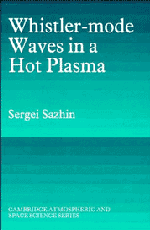Book contents
- Frontmatter
- Contents
- Acknowledgements
- Introduction
- 1 Basic equations
- 2 Propagation in a cold plasma
- 3 Parallel propagation (weakly relativistic approximation)
- 4 Parallel propagation (non-relativistic approximation)
- 5 Quasi-longitudinal approximation
- 6 Quasi-electrostatic approximation
- 7 Growth and damping of the waves
- 8 Non-linear effects
- 9 Applications to the Earth's magnetosphere
- References
- Solutions to the problems
- Index
6 - Quasi-electrostatic approximation
Published online by Cambridge University Press: 30 October 2009
- Frontmatter
- Contents
- Acknowledgements
- Introduction
- 1 Basic equations
- 2 Propagation in a cold plasma
- 3 Parallel propagation (weakly relativistic approximation)
- 4 Parallel propagation (non-relativistic approximation)
- 5 Quasi-longitudinal approximation
- 6 Quasi-electrostatic approximation
- 7 Growth and damping of the waves
- 8 Non-linear effects
- 9 Applications to the Earth's magnetosphere
- References
- Solutions to the problems
- Index
Summary
As was shown in Chapter 5, the quasi-electrostatic approximation becomes invalid when θ approaches the resonance cone angle θR defined by (2.23) or (2.24) (or θR0 defined by (2.13) in the case of a dense plasma, the contribution of ions being neglected). However, at θ equal to or close to θR we can use another approximation based on the following assumptions:
(1) The wave refractive index N is assumed to be so large that only the contribution of the terms proportional to the highest powers of N in the dispersion equation is to be taken into account.
(2) The plasma temperature is assumed to be so low that inequalities (1.77) are valid and the elements of εij can be written in the form (1.78), εijt and εijr being the perturbations of εij0.
The first assumption seems to be a straightforward one in a sufficiently low-temperature plasma, as in a cold plasma limit N20 ∞ and when θ → θR. However, the second assumption does not seem to be an obvious one since εijt ∼ N2 and εijt → ∞ as N2 → ∞. Thus N should be large enough to satisfy the first assumption but small enough to satisfy the second one. The validity of these assumptions can be checked by the actual value of N obtained from the solution.
- Type
- Chapter
- Information
- Whistler-mode Waves in a Hot Plasma , pp. 121 - 143Publisher: Cambridge University PressPrint publication year: 1993



